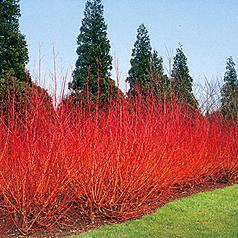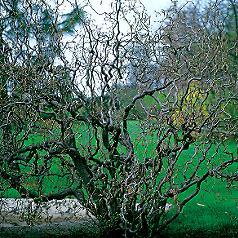One of the areas that I would like to improve upon in our garden is the lack of winter interest. I can look outside our windows and see lots of stark naked deciduous trees waving in the wind. If they were covered in snow we would have plenty of winter interest but here in Tennessee snowfalls of that magnitude are few and far between. Over the next several days I will talk about planning our winter garden and will end with planting a few things into it! Yes you can still plant trees and shrubs this time of year, in fact winter dormancy is an excellent time to plant them.
So what makes a winter garden? To me a winter garden has something unique to look at when the other plants are sleeping. Cool bark on trees, colored berries, interesting branching patterns, evergreen foliage, flowers and seed heads that sway in the wind are all things that come to mind when I think of a winter garden.

Colored berries are good for the eye as well as the birds. One of the reasons I garden is to attract wildlife. The deer come of their own accord (unfortunately) but the birds need motivation and providing garden plants that give them nourishment in the winter is a favor they will likely return with their presence. A family favorite the orange berry bush, better known as Firethorn (Pyracanthus augustifolia), is a great choice. The birds love the berries and the thorns provide them with a protected place to build their nests safely tucked away from any cat that might be hanging around. Many berry bearing plants like pyracantha are evergreen and do double duty in the winter. Hollies fit the bill. Their year round green color is decorated in the winter with red berries that birds really enjoy. One favorite holly of mine that I’m ashamed to admit I don’t have yet is the Winterberry Holly (Ilex verticulata). It’s actually deciduous but that just enhances its appeal. When the leaves drop off and reveal the abundance of bright red berries you end up with a spectacular winter show.
Harry Lauder’s Walking StickInteresting branching patterns can be found on many trees and shrubs. The corkscrew willows do exactly what their name entails and twist their limbs into various contorted formations. Speaking of contortions, what about the Contorted Filbert (Corylus avellana), also known as ‘Harry Lauder’s Walking Stick’. This small tree grows up to 15 feet tall and is one of the most twisted trees you will ever see. Vines also have interesting branching patterns and once they lose their leaves all is revealed.
Evergreen trees and shrubs abound. This list ranges from tall pines to dwarf conifers, arborvitae to evergreen azaleas. I’m partial to Bird’s Nest spruces and the dwarf cherry laurels (‘Otto Luyken’ or Schip are both also called English laurels) but there are so many great plants to choose from in the evergreen category. Even evergreen herbs like Rosemary can add winter interest. This time of year you will see quite a few rosemary plants trimmed up into little Christmas trees but you can trim them up into all sorts of topiaries.
Some plants even flower in the cold winter months. Heaths burst out in an explosion of little tiny blossoms during the winter months. I’ve added at least 5 Mediterranean White Heathers to various areas of our garden because of the flowers and evergreen foliage they present. Witch hazels are another good plant for flowers in the colder months. The streamer like blossoms that appear in the later winter and early spring are also very fragrant.
Seed heads might not be the most thought of element of a winter garden but really have a great amount of winter interest. Ornamental grasses are probably best known for their seed heads that flutter about like feathers in the wind, but what about other perennials? The seed heads of echinacea (coneflowers) are pretty in the winter as are the round seed globes left by gaillardia in the fall. There are all kinds of options out there.
I’ve given you a small glimpse into my mind’s planning process for our winter garden. (Hopefully it didn’t scare you any!) Tomorrow I’ll highlight the three kinds of plants with which I’ll begin our winter garden. As all my garden areas have the winter garden will expand over time.


Snow would make our gardens look spectacular! But we won’t have any so I am also looking at winter interest planting! This will be an the winter of planning and planting! I noticed that HD still has some nice shrubs available…how about in your neck of the woods?
I’ll be marking this post to refer to. I need winter interest also. I like all of your choices of course because I can grow them in my zone 7 garden. You bring up a good point about planting in mass. The red twig looks so much better when you have a lot of them.
Oh how funny!! I put a question mark after my name.
Good informative post – I was late in learning to add winter interest, now I think it is one of the most interesting times of year. Can you grow camellias or is it too cold for those?
Very interesting as if you have been reading my mind about winter plants. Looking forward to more.
This is a great post–I came late to the whole “adding winter interest” party, too, but I’m so glad I finally decided to add something to look at during the winter. I couldn’t agree more about seedheads–I think they tend to get overlooked, but I can’t imagine my winter garden without the seedheads of purple coneflower, black eyed susans, or agastache. I also like the graceful arch of buddleia seedheads, especially when we get a dusting of snow.
Hi Dave, we are all looking to you to lead the way with concise explanations of what to plant and why! Don’t you wish we had some snow to pretty it up here? Not happening I guess, even yesterday when they called for it all we got was icy pellet thingeys. Berries and bark will be our salvation!
Frances
Definitely need that winter interest and the evergreens are the best. I like the birds nest pine, and also mugo pines though neither grow in my garden. Will be looking forward to seeing the rest of your winter interest posts.
Check out Tyra today.
Ooops,
It was Bliss.Bliss
Gail,
Snow would look great! HD probably does have a few things left that look good but right now I’m committed to not buying any more plants this year! I’ve got to pause for a little while. I’ve picked out what is going in the ground already for the winter garden. At least for part 1!
Good ideas all. Carol at May Dreams Gardens was speaking of the same just a day or so ago. She thinks much of winter interest just looks like you did not do a fall clean-up. A valid point since we all have such different ideas of what is interesting or attractive.
I love the floppy ornamental grass,like prairie dropseed/sporobolus, as much as a tall strong ornamental grass. But those that prefer a neat structured look should stick to those types of grass that stand well through storms and winter, like the molinia or feather reed grass.Pictures in winter from the blogging community is very helpful with this.
Your heathers have a nice mounding habit that holds up well and stays neat looking all year.Those of us with a wilder eye can enjoy bare hosta and lily stems curving or standing in clumps above the tree litter.Or huge stands of Joe-pye-weed with its slowly decaying seed heads atop dark thick stems.Beauty is in the eye of the beholder where winter is concerned.We must keep our preference in mind.
I have many of the red osier dogwood but a species that is never quite as bright red as some of the cultivars. It is a deep brick red even when young and quickly becomes a reddish brown as the stems thicken with age. I cut back to the ground (rejuvenate) one clump each year so that every clump is cut back (or will be) about every four years.
Even though your winter is milder than our Chicago area this aspect of your garden will be interesting to watch develope.
Next year you must add more pictures of how the rain garden does…Gloria
Anna?,
They definitely have a great look! 😉
Phillip,
There are some camellias that will grow up here. I’ve been a little hesitant to try them outdoors and don’t really have room in the house to overwinter them.
Thanks Colleen!
Winter is one of those gardening seasons that gets neglected. I suppose people don’t think about it since stuff really doesn’t “grow”.
Frances,
I don’t know if my choices will impress anyone but it will definitely be a way to start a winter oriented garden. The trick of course is having it look great year round.
Tina,
Those two pines are very nice. I put in two of the mugos near the patio and I’m looking forward to seeing them grow.
Mother Nature,
She does have a very good post on winter color and some great ideas.
Gloria,
I missed her post, I’ll head over there and check it out. I suppose some of what is interesting just looks unkempt but I think a lot can look really nice with a combination of the wilder look and the more planned aspects. Yes the rain garden needs highlighted! I keep forgetting about it, but I have big plans for it this spring…just wait and see!
Snow seems to cover over a lot of garden “sins” in the winter months. I’ve never thought about winter gardens that don’t have snow! You’ve got some interesting plant suggestions here. I love that first photo of the flaming red salix branches!
I’m looking at winter interest in my garden as well but at the moment I am finding it abit overwhelming
Good list Dave. I will refer to it later. Maybe some of them I can use here in this Southern garden.